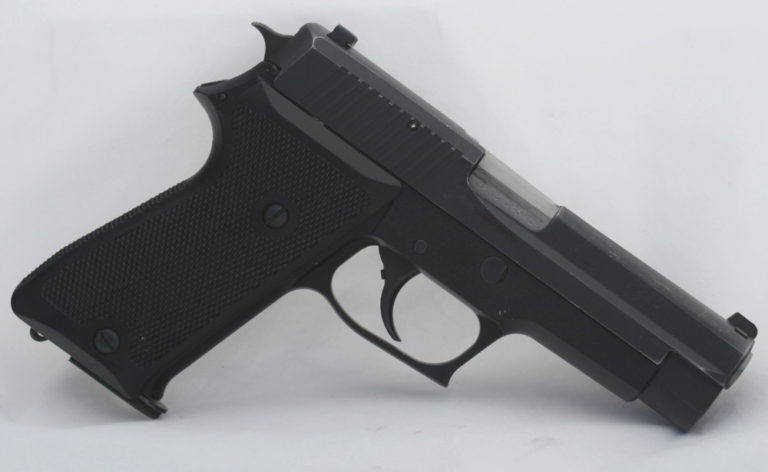
Massad Ayoob confesses that the SIG P220 is his very favorite SIG pistol, and indeed, one of his all-time favorite handguns. Extraordinarily accurate, very reliable, and easy to handle and shoot, one of the P220’s cardinal attributes is the cartridge for which it is chambered: the .45 ACP.
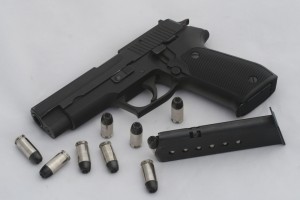 The P220 always fit most hands well. It always had good sights compared to most of its competition. And, of course, there was the reliability factor. The gun was and is extremely reliable.
The P220 always fit most hands well. It always had good sights compared to most of its competition. And, of course, there was the reliability factor. The gun was and is extremely reliable.
But the gun had other advantages, too. High among these was the double-action first shot mechanism. Police chiefs had been leery about carrying cocked and locked guns.
The long, heavy double-action pull required to initially unleash the firepower of the P220 was much like that of the revolvers that were so much a part of their institutional history. Cops in general and police chiefs in particular were and still are much more comfortable with a double-action like the 220.
Raise Your Sig Sauer IQ
Most 1911 pistols of the period were not “throated” by their manufacturers to feed wide-mouth hollow-point bullets, the choice of most police and gun-wise private citizens. Engineered with a nearly straight-line feed, the P220 was reliable with almost every hollow-point bullet.
There was also the accuracy factor. The SIG-Sauer pistols are famous for accuracy across the board, but the P220 may be the most accurate of them all. I have twice put five rounds from a P220 into one inch at 25 yards. Both times, the ammunition was Federal 185-grain JHP, which the manufacturer used to mark on the box as “Match Hollow Point.”
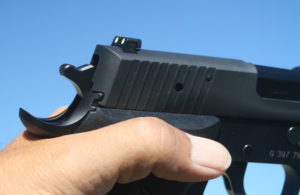 It was certainly truth in advertising. One of those guns was a well-worn P220 European, the other, a brand new P220 American. I later hit the 1-inch mark at 25 yards with a 5-inch SAO P220 and inexpensive MagTech 230 grain FMJ.
It was certainly truth in advertising. One of those guns was a well-worn P220 European, the other, a brand new P220 American. I later hit the 1-inch mark at 25 yards with a 5-inch SAO P220 and inexpensive MagTech 230 grain FMJ.
Almost every credentialed tester has noted the P220’s extraordinary accuracy. In his book The 100 Greatest Combat Pistols, defensive firearms expert Timothy J. Mullin had this to say about the P220. “All SIG pistols and products are fine weapons, but this one is particularly impressive.
My groups were so remarkable that I tested again at 25 and at 50 yards – and the results were just as superb. I placed five shots into a little more than 2 inches, and I pulled one of those shots. Four shots went into roughly 1-1/4 inches.” (1) A fan of SIG’s compact single-stack 9mm, Mullin added, “Although the P220 is not as good as a P225, I would rate it the top weapon that I tested in .45 ACP.” (Mullin’s emphasis.)
My friend Chuck Taylor is one of the leading authorities on combat handguns and the author of a great many articles and multiple books on the topic. When he wrote the fourth edition of The Gun Digest Book of Combat Handgunnery he had the following to say about the P220 .45.
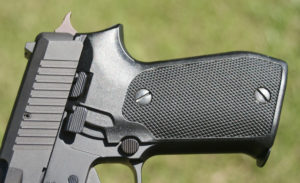 “First appearing almost two decades ago as the Browning BDA, the P220 in its current American version is regarded by many as being the state-of-the-art .45 auto. Indeed, its popularity is exceeded only by that of the Colt M1911 Government Model, whose king-of-the-hill status the P220 is now seriously challenging, especially in law enforcement circles.” Chuck continued, “The P220 is a simple design, perhaps as simple as a handgun can be and still work.
“First appearing almost two decades ago as the Browning BDA, the P220 in its current American version is regarded by many as being the state-of-the-art .45 auto. Indeed, its popularity is exceeded only by that of the Colt M1911 Government Model, whose king-of-the-hill status the P220 is now seriously challenging, especially in law enforcement circles.” Chuck continued, “The P220 is a simple design, perhaps as simple as a handgun can be and still work.
Its human engineering is excellent because, like its baby 9mm brothers, the P225 and P226, its controls are placed where they can be readily operated, something exceptional for a DA auto. Furthermore, its mechanical performance leaves nothing to be desired. It is probably the best DA self-loader around…In summary, the P220 is an excellent example of how good a DA auto can be. As such, it is well worth its not-inconsequential price and clearly a handgun upon which one could with confidence bet his life.”
Many double-action semiautomatics had a DA trigger pull that was heavy, rough, or downright lousy. The SIG’s double action pull was excellent, probably “best of breed.” It was the standard by which the competition was judged.
Once the first shot had been fired, it went to single-action, where the trigger press was a clean, easy 4 to 6pounds or so. The distance the trigger had to move forward to re-set the sear was just enough to give a buffer against unintentional discharges under stress, but not so great that it appreciably slowed down the shooter’s rate of fire.
With a 4.41-inch barrel, the SIG was a little longer in that dimension than the 4.25-inch Colt Commander, but more than half an inch shorter than the 5-inch Government Model. The Commander, originally introduced in lightweight format in 1949, weighed 26.5 ounces unloaded and held the same number of .45, .38 Super, or 9mm rounds as the P220. Later offered as the steel-framed Combat Commander, the Colt put on an additional 10 ounces in that format.
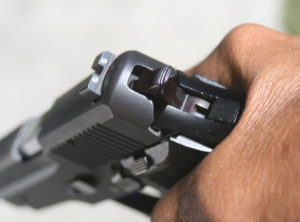 The lightweight Commander was dubbed by one of its greatest advocates, Col. Jeff Cooper, as “a gun designed to be carried much and shot seldom.” Most who had fired it considered it much more unpleasant to shoot than its big brother, the full-sized, all-steel Government Model.
The lightweight Commander was dubbed by one of its greatest advocates, Col. Jeff Cooper, as “a gun designed to be carried much and shot seldom.” Most who had fired it considered it much more unpleasant to shoot than its big brother, the full-sized, all-steel Government Model.
Thus it was that the cops and the shooting public were delighted to discover that the SIG P220, which like the lightweight Commander had an aluminum frame, wasn’t anywhere near as difficult to shoot as the alloy-framed Colt.
A major reason for the perception of the Commander’s vicious recoil was that, until the 1990s, its manufacturer furnished it with a short, stubby-tanged grip safety that bit painfully into the web of the hand whenever the gun was fired.
By contrast, the P220 was much rounder and more friendly to the hand. Nothing bit the shooter. In the P220, the low-pressure .45 cartridge simply drives the slide back with a gentle bump. Even though the slide of a 1911 pistol sits lower to the hand and should jump less since it has more leverage, anything that causes pain to the hand will magnify the shooter’s sense of recoil, and increase his likelihood of flinching and blowing each shot.
The P220 weighs a tad less than a lightweight Commander, 25.7 ounces unloaded. Yet most officers found it at least as pleasant to shoot as the full size 1911A1 in the all-steel configuration, which weighed some 39.5 ounces.
Only when a custom gunsmith (or, beginning in the 1990s, the manufacturers) put a beavertail grip safety on the lightweight 1911 did it become as comfortable to shoot as a P220, and allow the shooter to take advantage of the reduced muzzle jump potential afforded by its lower bore axis. However, none of this changes the other SIG attributes that made the P220 a favorite.
 A lightweight service pistol is especially important in law enforcement. The duty belt carries a great deal of equipment. The author has seen duty belts weighing in the 15- to 20-pound range once festooned with multiple handcuffs, a full-sized baton, heavy flashlight, portable radio, and ammunition.
A lightweight service pistol is especially important in law enforcement. The duty belt carries a great deal of equipment. The author has seen duty belts weighing in the 15- to 20-pound range once festooned with multiple handcuffs, a full-sized baton, heavy flashlight, portable radio, and ammunition.
The pistol is a significant part of the load, and any reduction in weight is appreciated. The weight of the duty belt is one reason why back problems in general and lower back problems in particular seem to be an occupational hazard of the street cop.
The pistol in its uniform holster rides near the edge of the hip, and on some individuals with some uniform designs, can directly contact the ileac crest of the hip. The potential for fatigue and discomfort is obvious.
Reducing the weight of the duty .45 from 39.5 ounces to 25.7 (the same round-count of the same ammunition adds the same weight to either) results in a 13.8-ounce weight saving – almost a pound – at a critical point.
Now, let’s look at plainclothes wear, whether in a detective assignment or off duty. The dress type belt, even a dress gunbelt, does not support the weight of the holstered gun as efficiently as the big, 2-1/4-inch-wide Sam Browne style uniform belt. A heavy gun becomes all the more noticeable. For generations, officers carried little 2-inch .38 caliber revolvers as off-duty guns, simply for their light weight and convenience.
However, they paid the price of a caliber that offered minimum acceptable power, especially when the ammunition was fired from a short barrel. They paid the price of a reduced in-gun cartridge capacity, only five to six rounds. They paid the price of a gun that kicked hard despite that minimum acceptable power level, and a gun that was difficult to shoot fast and straight, particularly at small targets or at longer range.
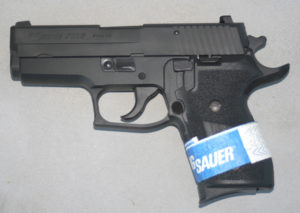 Now, the P220 .45 gives the plainclothes officer a much more attractive option. While not so small overall as a snubby .38, it is very flat. It fires the much more powerful .45 ACP cartridge, but despite its greater power it kicks less and is more pleasant to shoot than most snubbies.
Now, the P220 .45 gives the plainclothes officer a much more attractive option. While not so small overall as a snubby .38, it is very flat. It fires the much more powerful .45 ACP cartridge, but despite its greater power it kicks less and is more pleasant to shoot than most snubbies.
It is about the same weight as the six-shot Smith & Wesson Model 10 or Model 64 Military & Police revolver with a 2-inch barrel. And, of course, it is much faster to reload, and its flat magazines are much more discreet and comfortable to carry than speedloaders for a revolver when concealment is the order of the day.
With an inside-the-waistband holster and proper clothing, the P220 virtually disappears into concealment. With a well-designed scabbard riding on the outside of the belt, it is almost as easy to hide. The fact that a single pistol with which the officer is intensively trained could be used on or off duty, in uniform or in plainclothes, is another big factor in the P220’s favor when police departments look at purchasing new sidearms.
Related Video:
Raise Your Sig Sauer IQ:
- Sig Sauer Pistols
- P225-A1
- P320
- P516
- MCX
- P320C
- 516 Patrol Rifle
- P250
- P6
- M17 Civilian Variant
- P938
- P365
- P226
- P290RS
- MCX Rattler

Next Step: Get your FREE Printable Target Pack
Enhance your shooting precision with our 62 MOA Targets, perfect for rifles and handguns. Crafted in collaboration with Storm Tactical for accuracy and versatility.
Subscribe to the Gun Digest email newsletter and get your downloadable target pack sent straight to your inbox. Stay updated with the latest firearms info in the industry.

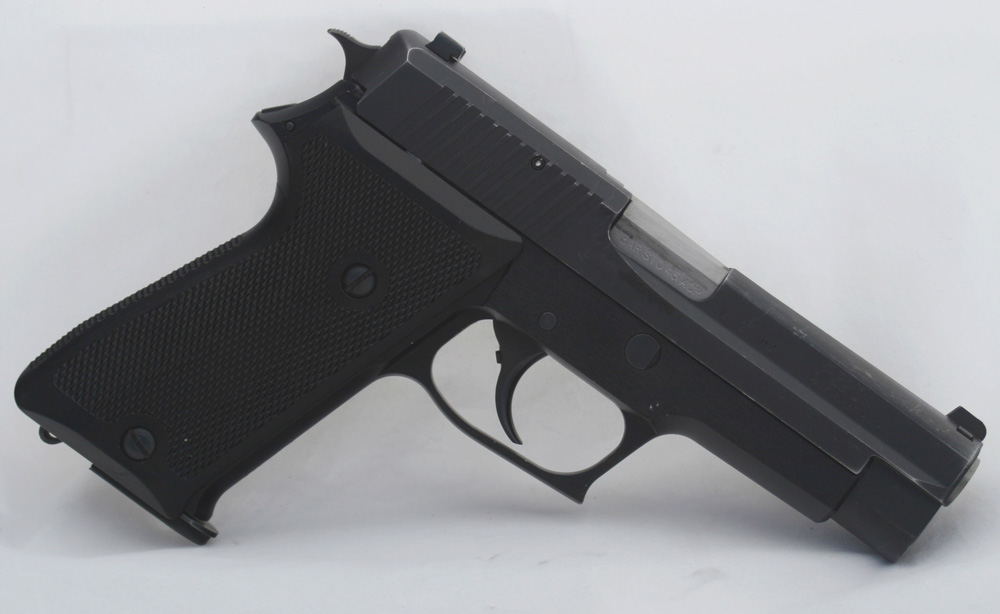
![Best Concealed Carry Guns In 2025 [Field Tested] Wilson Combat EDC X9S 1](https://gundigest.com/wp-content/uploads/Wilson-Combat-EDC-X9S-1-324x160.jpg)


![Best 9mm Carbine: Affordable PCCs [Tested] Ruger Carbine Shooting](https://gundigest.com/wp-content/uploads/Ruger-Carbine-Shooting-100x70.jpg)
![Best AR-15: Top Options Available Today [Field Tested] Harrington and Richardson PSA XM177E2 feature](https://gundigest.com/wp-content/uploads/Harrington-and-Richardson-PSA-XM177E2-feature-100x70.jpg)

I logged in searching for info on my own P220 – an European model chambered in 9mmPara (yes, they don’t make them anymore) – bought in 1980.
Suffice it to say, the comments from bhp0 is just not true. In terms of jamming and feeding different types of ammo – do this little test – get some empty (yes, empty) cases (i.e. horrific bullet pattern, no?), load them in the magazine, and then feed them through the pistol, one after another. No jams. Did you hear that? NO JAMS. Have never found ANY other pistol capable of doing that, reliably, all the time. Makes for a nice little party trick, by the way.
Its very well balanced & sits very well in the hand (much more “instinctively” than my Glock 26), and its very, very accurate – the author is spot on with his comments.
Here in good old S’Africa I rely on my old SIG P220 over anything else – yes, the magazine does not hold too many bullets, but who cares, you a) won’t miss you first (most important) shots (OK, first may go bit off due to the double action but second shot is dead on) &b) it won’t jam.
*Spoken like a good Beretta shooter bhp0!. The SIG 220’s, 226’s and 1911’s are all awesome. They shoot where you want and feed almost anything. All the nay sayers in the world can get me out of my German cars or guns – thank you very much.
The original P220 was a reverse engineered 9mm model which resulted in its jamming at the most inopportune times. Because it was reverse engineered it also could not function with sharp shouldered lead bullets like the super accurate Keith 200 grain semi-was cutter. Both the above problems stemmed from the fact that the empty case being ejected was actually pushing down on the top loaded round in the magazine and the rim of the ejected round would often catch on the mouth of the round waiting to be loaded or in the case of the lead bullet actually plow a groove through the shoulder and then peel back the case mouth like a banana resulting in a catastrophic jam with the loaded round on its way into the chamber. I am told more recent guns have an interrupter installed on them but how well this is going to work I cannot say at the present time.
Although the original flimsy stamped sheet metal slide has long since been obsolete the present guns not only suffer from past design problems but now have new ones as well. Several Gun Writers have stated the U.S. Military rejected the Sig P226 precisely because of its weak stamped sheet metal slide which as stated was replaced with the more expensive bar stock slide. Now lets face facts no company these days uses quality parts unless they absolutely have to and Sig would have never dropped the econo-grade stamped slide because they wanted too.
Now lets take a look at the design defects of this handgun.
The main spring of this gun is a throw back to one of the biggest turkeys of a handgun ever invented the P38. Sig borrowed the inferior mainspring position which resulted in the mainspring being positioned outside the back strap and covered only by the flimsy plasticky grips. In a fall or sudden impact the grips can shatter or crack and then the mainspring strut can become bent or even snapped in two putting the gun out of action.
The “P” series guns have also been put together with econo-grad stamped sheet metal roll pins which are not as strong or as durable as the old fashioned high quality solid pins. When the cheesey stamped sheet metal roll pins are removed for cleaning of the frame or repair they will not go back in as tight and should be replaced. As a matter of fact there is one roll pin in the top of the frame that has its rear end hanging out in thin air and is pressed down on by a very strong spring. If this pin snaps off or becomes loose it will fall down into the guns mechanism hopelessly jamming the gun up tight, just what you need in a gun fight to the death.
The magazine latch is very poorly designed and great care must be taken if you decide to remove it as its hair pin flimsy spring (which is way less durable anyway as compared to the rugged Colt/Browning coil spring) is not encapsulated and will fly off into the stratosphere when removed never to be seen again. As you can see this Mickey Mouse system is much inferior to the Colt/Browning system.
The frame of the “P” series guns is made of aluminum and as every knows who has used both aluminum framed versus steel frame guns the aluminum frame guns are inferior in regards to losing accuracy because they wear away quicker and are damaged more easily in an accidental dropping or fall.
The original hammer/trigger system was made not of high grade bar stock or forged parts but of a cheesy powdered compressed metal (sintered) later to be replaced presently with and even worse set of parts, the disastrously inferior MIM cast parts guaranteed to go snap, crackle and pop at the most inopportune times. Just what you need to defend your life with. What a joke.
The gun itself is one of the most poorly balanced hand guns I have ever held being on par with the P38 and both are top heavy and point about as naturally as an el-cheapo K-Mart electric hand drill.
In my own testing although accuracy was good (at least with the German Made guns) the P226 9mm was always inferior to old fashioned classic guns like the “Original High Power” or Neuhausen P210 or CZ 75 or THE FABULOUS STAR MODEL 30 which was the BEST HANDGUN OF THE 20TH/21st.CENTURY which actually endured 180,000 round wear tests, try that with any other modern plasticky or stamped sheet metal pistol. Naturally it is not made anymore because it was quality.
Sig also has had design changes to their extractors, long v/s short so here is another area to watch out for.
Yes and according not to me but by an article that first appeared in the American Rifleman Magazine that appeared when the Sig P220 was first introduced, the gun was designed to be made as fast and as cheap as possible. And I might add myself, “This they accomplished at the expense of durability, along with an inferior design wrote with problems, most of which never have or in some cases impossible to, correct with its ill conceived design.
Although even with people who should know better, the gun has always been rated high in “Snob Appeal” (only because it was made in Germany originally) reality is another story. In other words good workmanship is a plus but when coupled with cheesy materials and an inferior design it never has cut the mustard.
In conclusion a Colt/Browning this gun certainly is not and never can come close to being ever.
Maybe you handled a “norinco’ rip-off, but the P220 is a dream and 100% opposite of your tedious description.